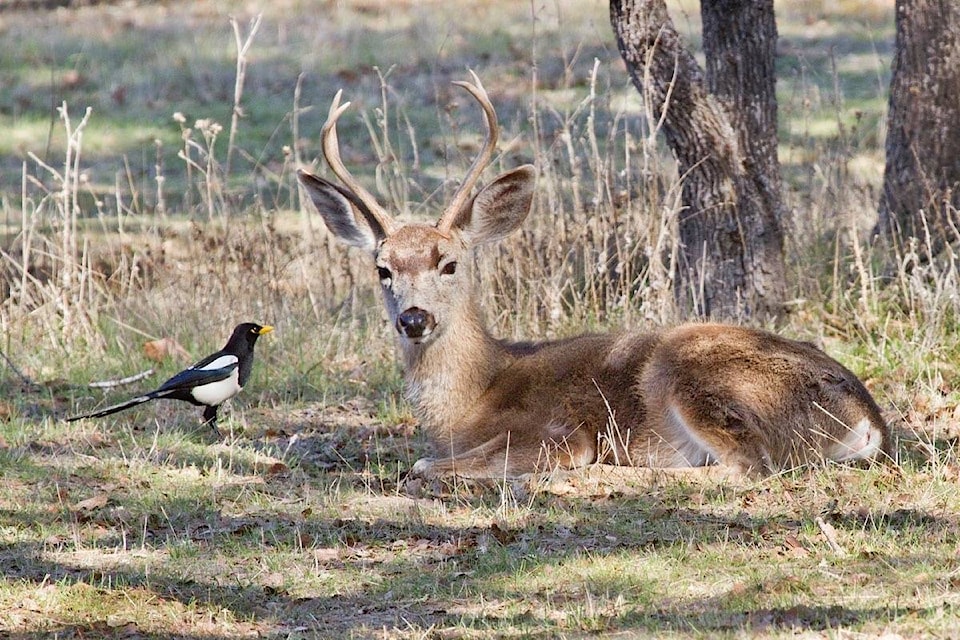It’s time to talk ticks, says a recent bulletin from Interior Health, and Frank Ritcey—the provincial coordinator for WildSafeBC—agrees.
“We’re in full-on tick season now,” he cautions. “You have to be careful, and don’t get them on you.”
Wood ticks—the most common type of tick in the Interior of B.C.—are about the size of a sesame seed, and live in tall grasses and in wooded areas. With the snow receding and the warmer weather finally here, more and more people are venturing outdoors, often into the heart of where ticks are residing.
“Stay on the main trails,” is Ritcey’s advice for those out walking or hiking in the back country. “If you go off the trail, into long grass, you’re more likely to get them. And where deer and bighorn sheep are: that’s where there are more likely to be ticks.”
He explains that ticks grow through four stages, including eggs, and at each stage they need a blood meal, starting with smaller creatures such as mice, other rodents, and cats, and gradually working their way up to larger hosts such as deer, bighorn sheep, and humans for their final big meal before laying eggs and starting the cycle again.
“They drop off the sheep and deer and lay their eggs,” says Ritcey. “You’ll see magpies sitting on the backs of deer and sheep, feeding off the ticks. It’s very beneficial.”
He stresses the need to check yourself and your pets for ticks when you return home.
“You don’t want them dropping off and laying eggs in your house. The female can lay up to 5,000 eggs. And you don’t quit getting ticks until you get the long, hot days.”
And while many people associate ticks with the wild, they can often be found in your own back yard. To help keep ticks away from your home and yard, keep your lawn short and remove any fallen leaves or weeds; keep a buffer area such as wood chips or a gravel border between your lawn and any wooded areas, and keep play equipment and play areas away from any woods; trim tree branches to allow more sunlight into your yard; keep woodpiles and bird feeders away from the house; and widen and maintain any trails on your property.
A major concern about ticks is the transmission of disease. “If ticks feed on an infected host, they can transmit that disease to the next host,” says Ritcey. Lyme disease is a very real fear when it comes to diseases spread by ticks, but Ritcey says that is spread by black-legged ticks, which are prevalent back east. Although they have been found in the Lower Mainland and Vancouver Island, he adds that it is his understanding that no black-legged ticks have been found in the dry Interior.
“That’s not to say that they don’t live here, but Interior Health averages one infection [of Lyme disease] every two years, and that doesn’t mean that people got it here.”
Wood ticks do not carry Lyme disease, but do carry Rocky Mountain spotted fever, which is very rare. Some wood ticks can also cause temporary paralysis in animals and humans, until they are removed.
“When they bite they release a toxin, and the smaller the person or animal the more effective the toxin will be.” Ritcey says that a person who suspects they have been infected should drink lots of water, and get to hospital as quickly as possible.
Ritcey says that people who are out walking can protect themselves from ticks by tucking their pants into their socks, as ticks will cling to low bushes and transfer themselves onto the flesh of any host that passes nearby.
He also advises that people use a DEET-based product and spray it onto their pants.
“You’ll see on Facebook people saying ‘You can use citronella oil’. If that stuff worked, we wouldn’t have had to come up with DEET. Natural remedies just aren’t very effective.”
If you find a tick on yourself, someone else, or on a pet, wear gloves and gently remove it, using a pair of needle-nose tweezers to gently grasp the tick close to the skin and pull it straight out without squeezing.
After removal, clean the area gently with soap and water. “You don’t want to get them embedded, so get them before they start biting,” says Ritcey.
“I don’t want people to be afraid of ticks; but it’s better to be aware.”
editorial@accjournal.ca
Like us on Facebook and follow us on Twitter
